
|
-The Intervention of Alien rule from 1194 C.E. up to 1947 C.E.
_____________________
_________________________________________________
The Hindu Struggle to Resist Muslim Aggression
In the earlier chapter covering the story of Prithviraj Chouhan the last Hindu Ruler of Delhi, we read how Muslim Rule was established at Delhi in the year 1194 C.E.
 | The fort of Gwalior.-This fort dates back to the 11th century and was originally built by the Tomara rulers whose adopted heir was Prithiviraj Chouhan - the last Hindu ruler of Delhi. The Gwalior Fort witnessed the chapters of the stout Indian resistance to the Muslims and later the British. Important rulers of this fort were Prithviraj Chouhan (circa 1190 C.E.), Man Singh Tomar (circa 1490 C.E.), Mahadji Shinde (circa 1761 C.E.) and Rani Laxmibai of Jhansi (circa 1857 C.E.) |
The very first Muslim attack on India had taken place nearly 500 years earlier in Sindh in the year 715 C.E. These Muslim invaders were Arabs led by Mohammad Bin Qasim. They had displaced Raja Dabir who ruled Sindh from his capital Deval (near modern Karachi). The actual reason for this invasion was that Raja Dabir was aiding the Iranian (Zoroastrian) princes in trying to overthrow the Arab Rule in Persia. This seems to be a fact as many Sassanian nobles from Iran had taken refuge in Sindh and were plotting for the liberation of their country from the Arab yoke. But the pretext given by Arab historians for the Arab invasion of Sindh is that Raja Dabir's navy had detained an Arab merchant ship. To avenge this detention of a merchant ship, the Arabs overran the entire kingdom of Raja Dabir as also the neighbouring kingdom of Mulasthana (Multan). They even unsuccessfully tried to attack Malwa (Malibah in Arab records)!
After this invasion which was limited to Sindh, for a period of 300 years all further Muslim attacks were thwarted by Kings like Raja Bhoja and other Gurjara Kings.
The second surge of the Muslim aggression began in 980 C.E. and lasted till 1020 C.E. This was the time when the Shahi Kings of Punjab grappled with the invaders. By the year 1020 C.E. Muslim rule had been established in Afghanistan, Paktoonistan (NWFP) and West Punjab. These Muslim invasions were led by Mahmud of Ghazni. The Rajputs ruling North India resisted further Muslim aggression.
The third wave of a successful Muslim invasion led by Mahmud Shabuddin Ghori (or Ghauri) took place between 1191 C.E. and 1255 C.E. This was the time the Muslims extended their occupation to Delhi. The lead role in resisting this invasion was played by Prithviraj Chouhan. This Muslim surge brought East Punjab, the Ganges Valley (Uttar Pradesh and Bihar) and Bengal under Muslim Occupation. This invasion reached up to Bengal where the last Hindu kingdom ruled by Laxman Sena was overurn by the Muslims. But the Muslims were checked and repelled when they tried to invade Orissa, where the Hindu King Narasimha Deva defeated Tugan Khan who invaded Orissa from Bengal. To commemorate this victory, Narasimha Deva erected the Sun Temple at Konark.
The next surge of the Muslim Invasion was launched from Delhi by Allah-ud-din Khilji in the year 1310 and was led by his general Malik Kafur. This invasion trampled the Hindu Kingdoms of the Yadavas of Devgiri in Maharashtra, the Kakatiyas of Warangal in Andhra Pradesh, the Hoysala of Belur-Halebid in Karnataka and the Pandyas of Madurai in Tamil Nadu. This invasion lasted till the year 1328 and with this invasion, except Orissa and Assam, the whole of India passed under Muslim Occupation.
The Hindu Struggle for Independence against Muslim Tyranny
Thus the struggle of the Hindus to resist the Muslim aggression into India was spread over a period of 600 years from 715 C.E. up to 1328 C.E. This contrasts with the the swift Muslim victories in Persia (Iran) over the Zoroastrian Sassanians and in Mesopotemia, Egypt and North Africa over the Romans (Byzantines). The Muslims could not subjgate India with ease. And even after subjugating different parts of the country, they were never able to rule it enitrely. The next 400 years from 1328 up to 1720 was marked by a valiant and ceaseless struggle for independence by Hindus to deliver India from Muslim tyranny.
This struggle was first led in North India by the Rajputs and then by the Jats, Marathas and Sikhs. In the South this struggle was embodied in the Vijayanagar Empire. This struggle for independence culminated when the Marathas began to bring an end to the Muslim domination of India. The Gurkhas came in later in the 18th century, but their activities also played a role in weakening the Muslim power in North India which was on its last legs in the 18th century. The Gurkha struggle was more with the British East India Company. But more of this later.
The Muslim rulers built on the same Feudal Base* of the Hindu Period…
But the successful aggression of the Muslim invaders did not change the Base of the earlier pre-Muslim society. Base* defined as the land ownership system and the system of making land grants to middlemen (feudal lords) who collected taxes for the higher authority - the king (Sultans of Delhi in the context of the middle ages). The very first act of the Muslim invaders was to pillage the well endowed Hindu temples at Somnath, Thanesar, Mathura, Kannauj; and other places. By this, with one stroke, the riches concentrated in the hands of these temples through many centuries of grants from Hindu rulers, fell into the hands of the Muslim invaders from Ghazni and Ghori.
..But the Muslims Aimed at Totally Destroying the Superstructure** Associated with the Hindu Period
The Muslims aimed to totally destroy the Superstructure associated with the Hindu period. The term Superstructure** which the Muslims aimed at destroying included a wide spectrum of aspects of social life including Indian religions (Hinduism, Buddhism, Jainism), language (Sanskrit and its various vernaculars), universities (like Nalanda), traditions of learning (ashramas, gurukulas), architectural symbols (temples, Chaityas, Viharas, Stupas), etc. The policy during the 700 years of Muslim occupation of India was to totally replace the superstructure of the Hindu period with a typical Muslim one.
Towards this end the Muslim invaders undertook the desecration of places of worship, destruction of universities like Nalanda, the wholesale slaughter of the monks and priests to wipe out the intellectual bedrock of the people they overran. Such tyrannical polices which the Muslim rulers folllowed since their rule was established in 1194 C.E. they left a trail of bitterness in the regions which passed under their domination. Hindu tradition survived only in remote corners of the country like in Orissa, Assam and parts of South India.
Contrasts between non-Muslim Invasions and the Muslim Aggression of India
Though the new rulers built upon the same feudal economic foundations of the Hindu period, they aimed at total destruction of the super-structure as it then existed. In the early days of their reign the Muslim rulers unleashed a reign of terror the kind of which India had never experienced before in its history.
Before, the Muslims, India had been invaded by the Greeks (Yavanas), Huns (Hunas), Shakas and Kushanas, but what contrasted their invasions from that of the Muslims was that, after their initial collision with Indian society, the previous invaders were completely absorbed into the existing Indian society. Even the memory of their ever having been foreign invaders was wiped out.
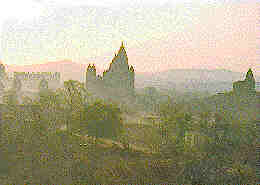 | Hidden fron the prying eyes of the Muslim iconoclasts, the temple complex at Orchha was created by the Bundela rulers of Central India in the middle ages. |
But the barrack-like lifestyle of the Muslims along with an attitude of contempt for everything associated with this country was to leave a split in India's national character when a significant part of the Indian population went over to the invaders by giving up their ancestral faith and embracing Islam.
Eclipse of Buddhism and Trying Times for Hinduism
The near total eclipse of Buddhism following the destruction of monasteries and the slaughter of monks by the Muslims in their headlong rush down the Ganges, establishes both - the fanatical ferocity of these intolerant invaders as also the changed character of Buddhism which had by then long lost its mass base. The religion had become highly centralised comprising mainly the monks at Nalanda and other universities. The eclipse of Buddhism stands in sharp contrast to the survival of Hinduism through 750 years of intolerance and persecution. This was so as Hinduism with all its superstitions and rituals was still anchored in the mass and had not become limited to being solely an intellectual tradition as had Buddhism.
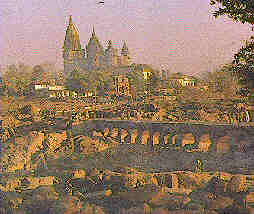 | In the rugged fastness of Bundelkhand the Bundela rulers tried to capture the magnificence of the bigger complex at Khajuraho while building the temple complex of Orchha. |
The Hindu-Muslim Conflict was Economic, Social, Cultural, Military and Religious
But the fierce conflict that featured the early days of the Muslim occupation of India, was in its hidden essence a conflict for domination, of which religion was only one aspect. This struggle was primarily between the Muslim nobility (Amirs) led by the Muslim Monarch (Sultan) on one side with the Hindu nobility and general Hindu population on the other.
To quote D.D. Kosambi , a contemporary historian, "The monarch's regulations were so strictly carried out that the Khuts, Mukaddims or Chaudhuris (Hindu noblemen and village headmen) were not able to ride on horse-back, they were not allowed to carry weapons or even to indulge in betel. These classes were brought to such a state of obedience that one revenue officer would string twenty Khuts, Mukaddims or Chaudhuris together by the neck and enforce payment by blows.
(D.D. Kosambi Introduction to the Study of Indian History)
The Lower Castes (Classes) Bore the Worst Burden - Religious Persecution in Addition to the Existing Economic Exploitation
The tactics of the Muslim monarchy were aimed at breaking the hold of the erstwhile Hindu feudal nobility on the society and the economy. At its core, the Hindu-Muslim strruggle was a brutal effort of a new ruling class of the Muslim conquerors in expropriating an older and established ruling class of its accumulated surplus along with the right to appropriate in the future.
The exploited classes of the former Hindu social structure did not experience any change in their economic position, but they now bore the additional burden of repression on religious grounds, the payment of Jazia (penal tax which the Hindus had to pay for refusing to convert to Islam), the waves of forced conversions, where they, like their more fortunate noblemen and upper caste fellow countrymen, were made to submit to 'Islam' at the point of the Sword, the destruction of their places of worship, and the arbitrary humiliation of the honour of their womenfolk, in addition to the discrimination in legal matters and a general status of being second class citizens. It was for these tyrannical policies that the Muslims were looked upon by all Indians as Mlechha (commonly pronounced as Mlench) - which in Sanskrit means "barbarian". But in all frankness, it should be said that despite Muslim tyranny, the lower castes of the Vaishyas and Shudras continued to be a tillers of the land with an obligation to part with a share of the crop to the state - whether Hindu or Muslim. Under Muslim rule their economic position did not change, but their social position became worse. In addition to being economically exploited, as they were earlier during the Hindu period, they were now also socially tyrannized along with the rest of their countrymen, by their new intolerant rulers - the Muslims
The Brief Revival of Slavery under Muslim Rule
Even the brief revival of slavery that took place under the Delhi Sultanate was in no way comparable to the institution which existed in the ancient Greco-Roman world. The Mohammedan rulers enslaved the subjugated native population in the form of domestic servants at their palaces. This institution of domestic slavery did not represent a productive organisation as it was in the world of antiquity. During the Sultanate, whenever the slaves under the Mohammedan feudal chieftain became too numerous the heads of these favoured servants were cut off without mercy and were made into heaps in front of the darbar" (court). (D.D.Kosambi, Kosambi Introduction to the Study of Indian History)
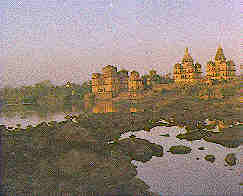 | The setting sun casts its glow on the Orchha temples across the river that flows past the complex. In the dark days of Muslim Rule the Bundela rulers not only tried to preserve their independence but also preserve a hoary tradition of temple building in an age when the Muslim aggressors spared no opportunity to vandalize any non-Muslim structure that could lay their hand on. |
This showed the low importance given to both human life and to the practice of slavery in the productive process. Had slavery occupied an important place in day-to-day production, such a massacre without impunity could never have taken place. Apart from the low importance attacked to slavery the massacres also reflect the ruthless mentality of the Sultans of Delhi.
Dynasties set up by the Muslim Aggressors in India from 1194 C.E. up to 1857 C.E.
After Mahumd Ghori's victory over Prithiviraj in 1192 and over Jaichandra in 1194, he left his Governor Kutub-ud-din Aibak to rule the conquered territories. After Ghori's death Kutub-ud-din set up an independent kingdom in 1206 and his dynasty is called the Slave Dynasty - after the background of Kutub-ud-din as a slave of Mahmud Ghori. The Slave Dynasty was succeeded by the following Muslim Dynasties viz. the Sayyeds, the Khiljis the Tughlaks and the Lodis. Between them they ruled Delhi and UP from 1206 C.E. up to 1527 C.E. Ibrahim Lodi, the last ruler of the Lodi line was defeated and killed by Babar who invaded India in 1527.
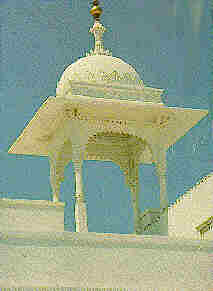 | A Marble Chattri at Udaipur. Udaipur means City of the Rising Sun. Like the Bundela rulers of Orchha, the Ranas of Udaipur defianly held aloft the banner of Indian independence in the darkest days of Muslim rule in India. |
The Moghul Badshahs
Babar came from Ferghana in Central Asia and he belonged to the Timurid line. Incidentally Babar decended from Tamerlane (Timur the Lane) who had invaded and devasted Delhi a hundred years before Babar's invasion. Babar established the Mughal dynasty which ruled from Delhi (and later from Agra) Between 1527 C.E. and 1690 C.E., the Mughals gradually expanded their hold over almost the whole of India. They ruled from 1527 upto 1857. There was a brief interregnum in their rule when Sher Shah Suri defeated and drove out Babar's son Humayun after the battle of Chausa. Humayun came back a few years later and defeated Sher Shah's son to re-establish the Mughal line. But the Mughal heyday can be said to have ended in 1707 with the death of Aurangzeb. The period from 1740, after Nadir Shah's (King of Persia) invasion and sack of Delhi, is dominated by the Marathas who held sway till 1803 when they were supplanted by the British as the informal overlords of the Mughals up to the abortive Sepoy Mutiny of 1857. After 1857, the Mughal (and Muslim) rule was formally abolished by the British.
But the fact to be noted here is that Sher Shah Suri who displaced Humayun for some years began a policy of rapproachment with the Hindu (Rajput) nobility. A policy which was continued and improved upon by Emperor Akbar with positive results for the expansion of the Mughal Empire.
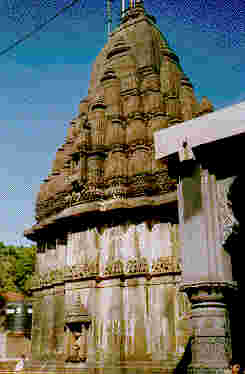 | Hidden fron the covetous eyes of the Muslim iconoclasts, the temple at Bhimashankar in Maharashtra was constructed in thick forests deep in a valley during the middle ages. |
Rapproachment between the Rajput Nobility and the Moghal Rulers
As we saw the policy of confrontation between the Mohammedan monarchy and
the Hindu landed nobility did not last forever. The later Muslim rulers (the
Mughals from Akbar to Shah Jahan) were shrewd enough to realise the long
term losses from such a friction with the Hindu landed nobility and were
quick enough to befriend their class brethren from a different faith. The
Akbarian policy of conciliation towards the Rajput feudal clans and the appointment of Hindu Mansabdars, Subahdars and Jagirdars (before Shivaji) by the Deccan kingdoms were efforts towards a co-ordinated exploitation of the peasant masses.
This policy was continued by the tyrant Aurangzeb especially for putting down revolts by the native princes . One instance is the appointment of Jai Singh Rajput, to lead the Mughal campaigns against Shivaji, which led to the treaty of Purandar between the Marathas and the Mughals. But despite this policy of appointing Hindu generals, Aurangzeb relentlessly followed a policy of persecution towards the Hindu masses. This represented a policy of co-ordination between the Mohammedan monarchy and a part of Hindu aristocracy (who went over to the new ruling class of the Muslims) against the local masses who overwhelming were Hindus.
Feudal Relations Remained Unchanged Irrespective of the Rulers being Hindu or Muslim
Thus whether in the Sultanate of Delhi or in the Mughal rule, or in the petty Muslim Kingdoms of the Deccan, or in the Vijaynagar empire or in that of the Marathas at a later stage, the feudal mode of production with its hierarchical apparatus remained unchanged. ln the place of the land grants like Bramhadeya Devadana and Aqrahara which existed during Hindu rule, we now had Inamdari, Jaqirdari, Subahdari, etc. The recipients of the land grants under the Delhi Sultans were only Muslims of Turkish and Persian extraction, who were joined by the Indian Muslim converts from the Hindu landed nobility and later in the time of the Mughals even the Hindu Rajput noblemen were given Jagirs, Subahs and Inams.
In spite of this compromise of the Hindu nobility with its Muslim counterpart, all through the Mohammedan rule an under-current of the state policy was
the aim of converting people to Islam.
How the Hindu Ruling Class - faced the Muslim Challenge in Various Ways
The conflict of interests between the two ruling classes of the Hindu landed nobility and the Muslim monarchy was partly mitigated by the continuing opposition to the Muslim power, as happened in the case of the Rajputs especially in Mewad (the line of Rana Sanga and Maharana Pratap of Udaipur/Chittor).
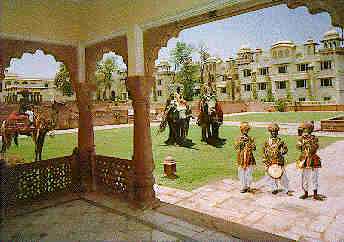 | The Rajputs were brave as well as proud. They lived a luxurious lifestyle built magnificent palaces rode caprisoned elephants fought one another bitterly and at critical junctures in Indian history their internecine rivalry cost the nation its sovereignty which passed into the hands of the invading Muslims. |
But in the Gangetic valley the Hindu landed nobility in most cases went over to the side of the Muslim Sultan, by getting themselves converted to the religion of the new rulers and thus retaining their positlon as the landed nobility alongwith the rights of revenue collection. The surnames Khatri, Chaudhary, Shah, Chohan, Patel, etc., still linger on in many Muslim families who were converts from the Hindu landed nobility. In Marwar (the house of the Suryavanshi Kachawahas of Amber/Jaipur), the erstwhile Hindu ruling families took the "honourable" course of giving away their daughters in marriage to the Muslim rulers of Delhi and thus saved their skin (and throne) all through the 700 years of Muslim rule.
The Marathas in the south also followed another "honourable" compromise with the victorious Muslims by offering to be mercenaries under the service of the Muslim rulers (Shahji Bhosale for example). It was only when a national revival took place under the leadership and vision of Chattrapati Shivaji Maharaj that the Marathas came into their own..
The Vijayanagar Empire
In around 1350, two brave Hindu youths named Harihara and Bukka set up the last major Hindu Kingdom of the south - Vijaynagar. We are told that these two youths had been captured in their early teens by Malik Kafur when he invaded South India. They had been brought up as Muslims at Delhi and had been sent to the south to govern the rebellious provinces.
But these two enterprising youths had different ideas. They had not forgotten who they originally were. They repudiated Islam and returned to their original faith. With the help of a sage named Madhavacharya, they established a powerful Hindu Kingdom at Hampi (called Vijaynagar).
 | Hampi the destroyed capital city of the Vijayanagar Empire. In around 1350, two brave Hindu youths named Harihara and Bukka set up the last major Hindu Kingdom of the south - Vijaynagar. We are told that these two youths had been captured in their early teens by Malik Kafur when he invaded South India. They had been brought up as Muslims at Delhi and had been sent to the south to govern the rebellious provinces. But these two enterprising youths had different ideas. They had not forgotten who they originally were. They repudiated Islam and returned to their original faith. With the help of a sage named Madhavacharya, they established a powerful Hindu Kingdom at Hampi (called Vijaynagar). The most illustrious ruler of this line was Krishna Deva Raya who ruled from 1519 to 1535. |
The most illustrious ruler of this line was Krishna Deva Raya who ruled from 1519 to 1535. This empire held its own as the last Hindu frontier against further Muslim incursions till 1565 when it failed to overcome the combined strength of the allied Muslim armies at the battle of Talikota in 1565.
It was the Marathas who a century later again raised the banner of independence.
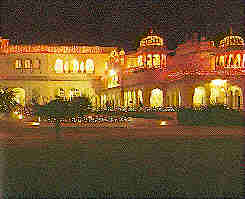 | The orante interior of Jaipur's Rambagh palace. A typical symbol of late Rajput architecture. However for all this glory, the Kings of Jaipur/Amber could preserve their throne during the Muslim rule giving away their daughters to the Mughal Rulers and serving as the paid servants in the Mughal armies against their fellow countrymen. Mirza Raja Jai Singh came on behalf of Aurangzeb to fight against Shivaji. Udai Bhan the renegade Rajput Mughal commandant of Sinhagad, fighting with whom Tanaji laid down his life, was one such renegade Rajput. Not to say that there were no renegade Marathas - there were many Suryaji Pisal and Chandrarao More to name two. On the other hand there were stout-hearted nationalist Rajputs like Maharana Pratap, Rana Sanga, Prithviraj Chouhan and many others. But it was the dark sheep who, to save their throne and skin, brought defeat and dishonour to the nation. |
_________________________________________
Now we move on to examine the period which marks the national revival under the Marathas that also marked the end of Muslim Rule in India.
_____________________________________________________________
_____________________________________________________________________________________
|
|
_ _ _ |
View My Guestbook
|
_______________________________________
_________________________________